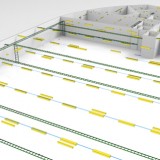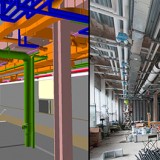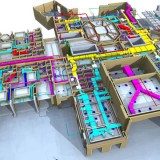
About BIM
Building Information Modelling (BIM) is a digital representation of physical and functional characteristics of a facility. A building information model is a shared knowledge resource for information about a facility forming a reliable basis for decisions during its life-cycle; defined as existing from earliest conception to demolition.
About openBIM
openBIM is a universal approach to the collaborative design, realization and operation of buildings based on open standards and workflows. openBIM is an initiative of buildingSMART and several leading software vendors using the open buildingSMART Data Model.
What are the practical problems occurring in the process of classic design and execution?
Projects of buildings, even the smallest, including serious challenges together. The successful implementation of construction projects is the result of collaboration between different professional teams, architects, various engineers, team principal contractor and subcontractor teams. These teams often have different priorities and belong to independent companies, whose interests often do not coincide. As a result, in most projects, the following problems occur in association:
- Lack of coordination in the work processes → parties involved usually do not coordinate with each other but only share documents
- Loss of information for the interpretation of the original data on the one hand, and by the other participants in the process
- Problems in the interpretation of data obtained from other participants → only in the case of a standardized process of interpretation this ceases to be a problem
- Limited use of information obtained from other participants → information generated by one group can not be fully utilized in other groups
- Inconsistency in the notification of changes → coordination does not mean an exchange of information, but a continuous, two-way process
- Lack of coordination between disciplines → full coordination between disciplines solves problems such as the detection of installation and civil conflict, specifically the statements quantity etc.
OpenBIM: Why is it important?
- openBIM supports a transparent, open workflow, allowing project members to participate regardless of the software tools they use.
- openBIM creates a common language for widely referenced processes, allowing industry and government to procure projects with transparent commercial engagement, comparable service evaluation and assured data quality.
- openBIM provides enduring project data for use throughout the asset life-cycle, avoiding multiple input of the same data and consequential errors.
- Small and large (platform) software vendors can participate and compete on system-independent, ‘best-of-breed’ solutions.
- openBIM energizes the online product supply side with more exact user demand searches, and delivers the product data directly into the BIM.
Basic characteristics OpenBIM concept
- integrated work process significantly reduces the possibility of errors in the coordination between architects and engineers during the design, construction and maintenance of the building, compared to the classic concept of files exchange between them
- project associates have absolute control and the possibility of free choice of software solutions (platforms) for its work, in terms of not only language adaptation (localization) but compliance with applicable local technical and other legislation, etc., The only requirement is that the software used BIM compatible
Who benefits from standardized BIM-processes?
- Owners, architects, engineers, facility managers, because they do not need to re-invent the wheel in each project, and because everyone would know the standard procedures. It will be much easier to partner-up in new projects and to build consortia. A lot of money and effort will be saved.
- Software vendors, because the market will become much bigger. As procedures become widely accepted state-of-the-art, vendors will increase investment in software development.
- Educators, because education is based on state-of-the-art, only on this basis a mass-education can be established and it is worth the effort to develop educational books/media (anything else is just short-term training). Certificates of education need a standardized basis. State-of-the-art is also a necessary basis for accreditation of studies.
- Building owners, because they will ask for state-of-the-art BIM competence confirmed by certificates.
- Contractors, manufacturers, authorities, maintainers and operators, because their work processes will be streamlined and efficient.
- Everyone in society, because they use the built environment for living, working and life





